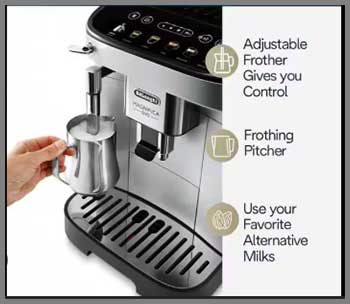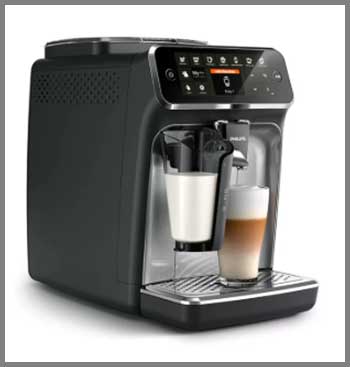I’m a coffee enthusiast who’s spent years chasing the perfect home-brewed espresso, and I’ve tested my fair share of machines. Today, I’m putting two heavyweights head-to-head: the DeLonghi Magnifica Evo and the Philips 4300 LatteGo. My goal?
To help you decide which super-automatic espresso machine deserves a spot on your kitchen counter. I’ll break down their features, share my hands-on experience, and weigh the pros and cons to guide your choice. Whether you’re a busy parent or a budding barista, let’s find your ideal coffee companion.
Comparison Table: Delonghi Magnifica Evo Vs. Philips 4300 Lattego
| Feature | DeLonghi Magnifica Evo | Philips 4300 LatteGo |
| Price (Approx.) | $699.99 | $624.90 |
| Grinder Type | Steel Conical Burr (13 settings) | Ceramic Flat Burr (12 settings) |
| Milk Frothing System | LatteCrema (Automatic) | LatteGo (Automatic) |
| Drink Options | 7 One-Touch Recipes | 8 Pre-Programmed Drinks |
| User Profiles | No (My Latte Memory Function) | Yes (Up to 2 Profiles) |
| Display | Soft-Touch Buttons, No Screen | Touchscreen Interface |
| Double Shot Feature | Manual (Press Espresso Twice) | Automatic (Doubles Coffee Dose) |
| Iced Coffee Option | Yes (One-Touch Over Ice) | No (Manual Adjustment Needed) |
| Cleaning | Removable Brew Group, Dishwasher-Safe Parts | Dishwasher-Safe Parts, Easy LatteGo Rinse |
| Dimensions | 14.2 x 9.5 x 17.4 inches | 17 x 38 x 10.6 inches |
| Warranty | 2 Years | 2 Years |
My Journey With Super-Automatic Espresso Machines
I’ve always loved the idea of café-quality coffee at home, but my early attempts with manual espresso machines were a mess—grounds everywhere, inconsistent shots, and a steep learning curve. Super-automatic machines changed the game for me. They grind, tamp, brew, and froth milk with minimal effort, making them perfect for busy mornings or when I want to impress guests without breaking a sweat. The DeLonghi Magnifica Evo and Philips 4300 LatteGo are two of the best in the mid-range market, but they cater to slightly different needs. Let me walk you through my experience with each.
Delonghi Magnifica Evo: The Italian Barista

When I unboxed the DeLonghi Magnifica Evo, I was struck by its sleek, compact design. It’s like a little Italian sports car for your countertop—matte black with silver accents, measuring just 14.2 inches tall and 9.5 inches wide. It fits snugly in my small kitchen, leaving room for my toaster and kettle. The build feels solid, with a mix of high-quality plastic and stainless steel that screams durability.
Key Features That Stood Out
The Magnifica Evo’s steel conical burr grinder is a standout. With 13 grind settings, I could dial in the perfect fineness for my beans, from light roasts to oily dark ones. The grinder’s consistency impressed me—every shot had a rich crema and bold flavor. The LatteCrema milk system is another gem. It’s automatic, so I just pop in the carafe, select my drink, and get silky foam for cappuccinos or lattes. The “My Latte” function lets me save my preferred milk-to-coffee ratio, which is handy for my daily flat white.
The machine offers seven one-touch recipes, including espresso, cappuccino, latte macchiato, and a unique Over Ice option for iced coffee lovers like me. The soft-touch buttons are responsive, though I accidentally triggered a brew a few times by brushing against them. One quirk: the double-shot feature doesn’t grind extra coffee; you need to press the espresso button twice for a stronger dose. It’s a minor hassle but worth noting.
Also read: My Thoughts on Kiala Greens Vs. AG1.
Pros of the DeLonghi Magnifica Evo
- Rich Espresso Flavor: The steel grinder and smaller portafilter holes deliver a fuller-bodied shot with excellent crema. I found the espresso consistently outperformed my old Nespresso.
- Compact Design: Its slim profile is perfect for small kitchens. I love that it doesn’t dominate my counter.
- Iced Coffee Mastery: The Over Ice setting brews a concentrated shot that doesn’t dilute over ice, making it my summer go-to.
- Easy Maintenance: The removable brew group and dishwasher-safe parts make cleaning a breeze. I spend maybe 10 minutes a week on upkeep.
- Customizable Milk Froth: The LatteCrema system lets me tweak foam texture, from dense for lattes to airy for cappuccinos.
Cons of the DeLonghi Magnifica Evo
- No User Profiles: Unlike the Philips 4300, it doesn’t save multiple users’ preferences, which is a pain when my partner wants a different brew.
- No Touchscreen: The button-only interface feels a bit dated compared to the Philips’ sleek display.
- Double Shot Workaround: Having to press the espresso button twice for a double shot feels less intuitive.
- Milk Carafe Maintenance: The milk tube needs regular rinsing to avoid clogs, which adds a step to my routine.
- Noisy Grinder: It’s not deafening, but the grinder’s hum is noticeable in the early mornings.
My Daily Routine With The Magnifica Evo
Mornings start with a quick espresso—40 seconds from bean to cup. The machine heats up fast, so I’m not twiddling my thumbs. For my afternoon latte, I fill the milk carafe, select “My Latte,” and get a perfectly balanced drink. Cleaning is straightforward: I rinse the brew group weekly and run the automatic descaling cycle every few months. The Over Ice feature was a game-changer during a heatwave, delivering café-style iced coffee without the watered-down taste.
Philips 4300 Lattego: The Dutch Innovator
The Philips 4300 LatteGo feels like the tech-savvy cousin of the Magnifica Evo. It’s taller at 17 inches and wider at 38 inches, so it takes up more counter space. The high-gloss black finish and touchscreen display give it a modern, almost futuristic vibe. I felt like I was operating a spaceship when I first set it up, though the menu navigation took some getting used to.
Key Features That Impressed Me
The ceramic flat burr grinder with 12 settings is quieter than the DeLonghi’s and runs cooler, preserving coffee oils for a smoother flavor. I noticed less grind retention, meaning fresher shots. The LatteGo milk system is a revelation—two dishwasher-safe parts, no tubes, and a 10-second rinse under the tap. It froths milk beautifully, though the foam is thicker, almost meringue-like, which isn’t always ideal for lattes.
With eight pre-programmed drinks, including flat whites and Americanos, the Philips offers more variety. The touchscreen lets me tweak strength, volume, and milk settings easily. User profiles for two people are a lifesaver—my partner’s cappuccino settings are saved, so no more fiddling. The double-shot feature grinds extra coffee automatically, which is more convenient than the DeLonghi’s workaround.
Pros of the Philips 4300 LatteGo

- Intuitive Touchscreen: The display is responsive and easy to navigate, even for tech novices like my mom.
- User Profiles: Saving preferences for two users makes it ideal for couples or roommates.
- Effortless Cleaning: The LatteGo system is a dream—no tubes, no fuss. I rinse it in seconds.
- More Drink Options: Eight recipes give me more variety, especially for guests who want something fancy.
- Strong Double Shots: The automatic double-dose feature makes robust coffee without extra steps.
Cons of the Philips 4300 LatteGo
- Bulky Footprint: It’s a space hog, which was an issue in my cramped kitchen.
- Thick Milk Foam: The LatteGo’s foam is too stiff for my taste, making lattes feel heavy.
- No Iced Coffee Setting: I had to experiment to avoid diluted iced drinks, which was frustrating.
- Louder Operation: The grinder and frother are noisier than the DeLonghi, waking my cat more than once.
- Less Bold Espresso: Shots tasted lighter compared to the Magnifica Evo, even with dark roasts.
Read More: My Thoughts on Nectar Vs. Liquid IV.
My Daily Routine With The Philips 4300
The Philips 4300’s touchscreen makes mornings fun—I tap my profile, pick an espresso, and it’s ready in under a minute. The LatteGo system shines for cappuccinos, though I wish the foam were silkier. Cleaning is a breeze; I rinse the milk container after each use and pop it in the dishwasher weekly. I struggled with iced coffee, as the standard brew diluted over ice, so I dialed in a stronger shot manually. The user profiles saved my sanity when my partner kept switching settings.
Head-To-Head: Which Machine Wins?
Both machines deliver café-quality coffee, but they shine in different areas. Let’s break it down by key factors.
- Espresso Quality
The DeLonghi Magnifica Evo takes the crown here. Its steel grinder and smaller portafilter holes produce a richer, more aromatic espresso. I consistently got a thick crema and complex flavors, especially with medium roasts. The Philips 4300’s ceramic grinder is solid, but the shots tasted lighter, even after tweaking settings. If espresso is your priority, the DeLonghi is the better bet.
- Milk Frothing
The LatteGo system on the Philips 4300 is easier to clean, hands-down. Its tube-free design is perfect for busy folks. However, the DeLonghi’s LatteCrema system wins for froth quality. I loved the silky texture for lattes, and the adjustable foam let me experiment. If you drink milk-based beverages often, decide whether cleaning ease or foam quality matters more.
- Ease of Use
The Philips 4300’s touchscreen and user profiles make it more intuitive, especially for multiple users. The DeLonghi’s soft-touch buttons are simple but lack the modern flair. First-time buyers or tech lovers might prefer the Philips, while traditionalists will vibe with the DeLonghi’s tactile controls.
- Cleaning and Maintenance
Both machines are low-maintenance, with removable brew groups and dishwasher-safe parts. The Philips edges out slightly thanks to the LatteGo’s quick rinse, but the DeLonghi’s automatic cleaning cycles keep things hassle-free. Neither will bog you down with chores.
- Design and Footprint
The DeLonghi Magnifica Evo is compact and elegant, fitting small spaces like a glove. The Philips 4300’s bulkier build and high-tech look suit larger kitchens but feel out of place in cozy setups. If counter space is tight, go with the DeLonghi.
- Price and Value
At $699.99, the DeLonghi is slightly pricier than the Philips at $624.90, but both offer great value for mid-range super-automatics. The DeLonghi’s superior espresso and iced coffee feature justify the extra cost for me, but the Philips’ user profiles and drink variety might sway budget-conscious buyers.
My Verdict: Who Should Buy What?
After weeks of testing, I lean toward the DeLonghi Magnifica Evo. Its rich espresso, compact design, and iced coffee prowess align with my needs as a daily espresso enthusiast with a small kitchen. The LatteCrema system’s froth quality sealed the deal for my latte obsession. However, the Philips 4300 LatteGo is a fantastic choice if you value user profiles, a modern touchscreen, and minimal cleaning effort. It’s ideal for households with multiple coffee drinkers or those who love experimenting with drink options.
Your choice depends on your priorities. Love bold espresso and iced coffee? Go DeLonghi. Need convenience and variety? Philips is your match. Either way, you’re getting a machine that’ll elevate your coffee game.
Frequently Asked Questions (Faq)
DeLonghi is an Italian brand, and the Magnifica Evo reflects its heritage in design and espresso quality.
The Magnifica Evo comes in models like ECAM29084SB (with LatteCrema) and ECAM29043SB (manual frother).
The Magnifica Evo is an entry-level model with fewer drink options and no touchscreen, while the Dinamica Plus offers a 3.5-inch display, more recipes, and app connectivity.
Yes, it brews regular coffee via the “Coffee” or “Americano” one-touch options.
Conclusion: Your Perfect Coffee Awaits
I’ve spent countless mornings with the DeLonghi Magnifica Evo and Philips 4300 LatteGo, and you’ll love how they transform your coffee routine. The DeLonghi’s bold espresso and compact charm won my heart, but the Philips’ tech-savvy features and easy cleaning are hard to beat. You can’t go wrong with either, but think about what matters most—flavor, convenience, or space. Pick the machine that fits your lifestyle, and you’ll be savoring café-quality coffee at home in no time. Which one’s calling your name?
